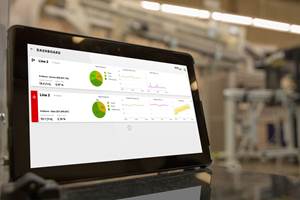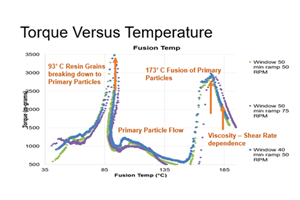Capacitance Gauges Come of Age For Blown-Film Thickness Control
Thanks to recent technical advances, relatively inexpensive capacitance thickness gauges reportedly are now stable enough for reliable closed-loop control, not just monitoring thickness variations. Another big step forward for capacitance gauges is the arrival of non-contact heads that can be mounted on the bubble instead of farther downstream on the layflat, thereby allowing quicker response to thickness variations.
Capacitance gauges measure the ability of a plastic to hold an electrical charge and convert that number into thickness. Early versions got a bad name because they tended to drift and could be thrown off by changes in film temperature, ambient air temperature, humidity, and other variables. So most older capacitance gauges are used to monitor film thickness but not control it.
That has now changed as a result of many developments, says Albert Keller, president of Kundig International Inc. of Wellesley, Mass., the market leader. He cites as examples new automatic adjustment of sensor position relative to the bubble, faster scanners that travel around the bubble, and new coatings on sensors to reduce friction.
Capacitance gauges are almost entirely used on blown film. In fact, several makers of the instruments won't sell them for cast film because they're imprecise at measuring the edges of the film.
Capacitance gauges are 15-25% less expensive to install than nuclear gauges and easier to maintain without the environmental regulations affecting nuclear products, says Neil Sticha, president of Oakland Instruments, St. Paul, Minn., which supplies capacitance gauges. Because of European restrictions on nuclear gauges, capacitance types are far more popular there than in the U.S. Kundig International has over 500 worldwide, but fewer than 50 in the U.S. Plast-Control, Newburyport, Mass., has 300 in Europe, but only four in North America. Sussex Gauging in the U.K. (represented here by Oakland Instruments) has seven capacitance gauges on blown film lines in Europe but only three in North America.
Sensing sticky bubbles
Non-contact heads allow measuring of films with tacky surfaces or optically clear films that could be scratched by a contacting sensor. Non-contact heads are also useful for very thin (half-mil) films and for lines that experience frequent product changeovers.
However, until recently, non-contact heads were available only for use on the layflat, where the film could pass between two capacitance-sensor electrodes. Not only did that delay response to gauge variations, but it meant measuring two thicknesses of film, adding together the thicknesses of two points several inches apart on the bubble.
The first commercial non-contacting capacitance head for mounting on the bubble was launched this year by Sussex. The Sussex head rides on a patented air cushion a few thousandths of an inch from the bubble. Air-cushion pressure is regulated to match the pressure inside the bubble (0.1-0.5 psi). It was shown for the first time at the K'98 show in Germany.
Kundig first announced a noncontact capacitance head four years ago, but it proved not to be robust enough for an industrial environment. Now Kundig has a patent pending for a new, automatically controlled gap between film and sensor. It may be introduced by the NPE 2000 show in June if patent issues with Sussex are resolved.
Faster loop
Faster rotating rings allow quicker response time for closed-loop thickness control than does a fixed gauge on the collapsing frame, which measures a complete circumference of the bubble at the slower rotation rate of an oscillating die or haul-off. Two years ago, Kundig introduced a faster scanner that makes a circuit of a bubble in just 50 sec.
Plast-Control also offers a new high-speed scanner for capacitance sensors that can complete a circuit of the bubble in as little as 30 sec.
Meanwhile, Sussex has a new ring mounting arrangement called "Robohead," which has a servo-driven arm and two ultrasonic sensors to position a non-contact capacitance gauge on the bubble during startup or to "zero" the gauge. Two sensors let this device measure a slightly distorted bubble close to the nip, with the second sensor correcting for angular errors. One rotation typically takes 2 min. Sussex launched Robohead at K'98.
Less costly control
Of the capacitance gauges now being used in closed-loop control, most control local thickness deviations around the bubble circumference. Now SolveTech in Claymont, Del., has developed an inexpensive ($14,500) retrofittable capacitance gauge to control average film thickness in the machine direction via closed-loop regulation of haul-off speed. SolveTech's new device is a far less expensive package than one that works with an automatic die or air ring for bubble profile control. It's used after the layflat in blown-film lines that have an oscillating haul-off. SolveTech is installing its first system now and already has orders for 40 more next year.
SolveTech says its new system includes new calibration and edge-positioning technology and is accurate within ±10 micro-inches (0.00001 in.). Simplified calibration takes only two capacitance measurements--one with a film of known thickness between the capacitance-sensor electrodes and one with no film present.
SolveTech's new edge-positioning system keeps the capacitance head always within 0.25 in. of the edge of the layflat, which means that it measures two thicknesses of film that are only 0.5 in. apart on the bubble.
Related Content
How Inline Vision Inspection Can Minimize Scrap in Molding
Once viewed by injection and blow molders as a necessary evil, machine vision technology today can continuously monitor and improve production while reducing costs.
Read MoreInline Inspection System for Wood Plastic Composites
Pixargus’ ProfilControl 7 DX WoodPlasticComposites measure all dimensions and geometrics, including deep grooves.
Read MoreTry This Alternate Method for Heating Your Torque Rheometer
Rheometers are generally not on all the time. And most users have found that the first test run in the instrument after heating up is not very reliable and is usually discarded. Try this method instead.
Read MoreTracing the History of Polymeric Materials -- Part 30: Polyurethane
In the world of polymers, polyurethane chemistry is probably the most versatile. This a resulted in a wide range of products made from these materials and given the industry the flexibility to respond to the progressive march of regulatory concerns.
Read MoreRead Next
Troubleshooting Screw and Barrel Wear in Extrusion
Extruder screws and barrels will wear over time. If you are seeing a reduction in specific rate and higher discharge temperatures, wear is the likely culprit.
Read MoreLead the Conversation, Change the Conversation
Coverage of single-use plastics can be both misleading and demoralizing. Here are 10 tips for changing the perception of the plastics industry at your company and in your community.
Read MoreUnderstanding Melting in Single-Screw Extruders
You can better visualize the melting process by “flipping” the observation point so that the barrel appears to be turning clockwise around a stationary screw.
Read More






















